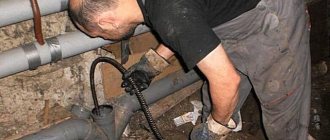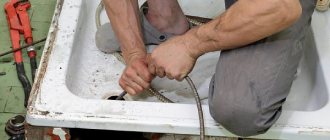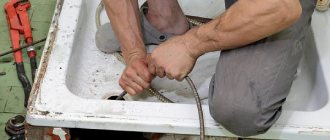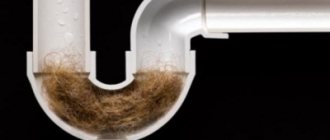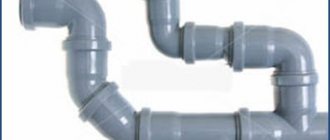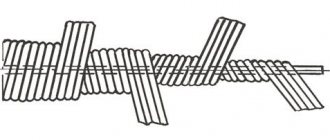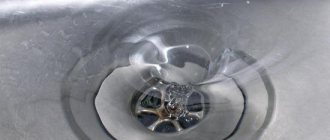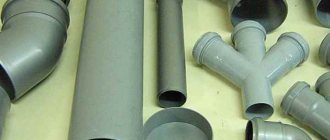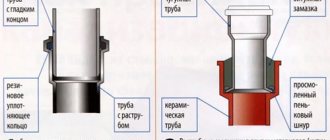Clogged sewer pipes are a problem that every homeowner faces sooner or later, no matter how carefully he uses all communications. Some may argue that it is enough not to flush large debris into the drainage system, but grease that gets into the drain abundantly when washing dishes, cleaning and cooking also causes trouble.
Let's figure out what inconvenience it causes and how to get rid of it.
Popular chemicals
How to flush sewer pipes? The “Mole” remedy has been known to many families for several generations, as it has been used for quite a long time. With its help you can remove plugs from hair and threads, fatty organic compounds. Used for all types of sewer pipes. It is also used to prevent blockages.
Liquid product – “Mole”
How to clean sewer pipes in case of serious blockage? In this case, it is worth using Tiret: it is safe for metal and other types of sewer pipes. The brand's line includes products to prevent congestion, which allows you to use a strong and expensive base gel much less often. Country of origin: Poland.
Types of gel:
- Professional.
- Turbo.
- Preventive
The types differ according to the percentage of active substances.
Mister Muscle cleaner
Flushing sewer pipes is possible using products from the Mister Muscle brand. This product is gentle on sewer pipes and has many positive reviews from consumers. Foam and gel are available for sale. The most effective solution in case of blockage is foam. The product dissolves organic deposits, eliminates unpleasant odors, and destroys bacteria.
You can get rid of clogs in sewer pipes using a chemical product produced in Israel, Baghi Pothan.
Causes of blockages removed by the product:
- Hair.
- Fat.
- Paper.
- Limescale.
Designed for cleaning metal and plastic pipes. It is recommended to avoid contact with the surfaces of bathtubs, sinks, washbasins, not to mention the skin of humans and animals.
When using this product, you should be very careful, since the reaction occurs immediately after adding water. Before pouring in the chemical, it is necessary to remove 5 cm of water standing in the drain. It is recommended to turn on the hood and open the windows during the cleaning process.
"Bagi Pothan" - a means of combating blockages
The Floop product is available in granules. Types of product release:
- For filling with hot water.
- For filling with cold water.
Floop granules, designed for pouring hot water, act much faster. The powder is poured into the drain hole, half a glass of hot water (70-80 degrees) is poured, left for some time (according to the inscription on the package) and washed with large quantities of water. Work is carried out with gloves, carefully avoiding contact with eyes and skin.
Granular product
By using chemicals, you not only solve the problem of blockage, but also disinfect the sewer pipeline, getting rid of bacteria and unpleasant odors. For long-term operation of the sewage system without blockages, it is necessary to carry out preventive cleaning using chemicals intended for this purpose.
Deboucher
Heavy-duty liquid preparation for cleaning sewer pipes. Suitable for cleaning pipelines made of gray PVC, polypropylene and metal. Fights organic, grease, soap and lime deposits, paper debris, cigarette butts, hair and wool.
The product is an alkaline concentrated liquid of a reddish hue. The composition includes two alkalis - potassium hydroxide and sodium hydroxide, as well as chlorine and active additives. The listed compounds significantly accelerate the chemical reaction, and the rate of deposit resorption increases.
The cleaning agent is poured into the drain and left for 1 hour; if you use the composition for preventive purposes, the cleaning time can be reduced.
It is not allowed to mix this drug with other cleansers or with bleach or soda. When the product gets into the drain, an exothermic reaction occurs, so you need to make sure that the foam does not get on your hands or eyes.
The disadvantage of the drug is that this product is contraindicated for cleaning metal, in particular aluminum pipes, due to the high chlorine content. Another disadvantage of the Deboucher gel is its low cost-effectiveness: you will have to spend at least half a liter of product on one fill.
Cleaning at home
If the blockage in the pipes is not too global, then you can deal with it using home methods. Among them:
- Cleaning the system with a plunger.
- Use of household chemicals.
- Cleaning with a plumbing cable.
Using a plunger
Using a plunger - the simplest plumbing tool - cleaning pipes is easy and safe. The work goes like this:
- If there is an overflow hole in the sink, it must be tightly plugged with a stopper.
- A small amount of water is collected in the sink.
- Now you need to install the plunger so that its rubber part completely blocks the drain hole.
- Having finished swinging, you need to sharply pull the plunger out of the water.
- If after this the collected water easily goes down the drain, it means that the cleaning of the sewer pipes was successful. Otherwise, you should repeat the operation 1-2 more times.
Chemical cleaning methods
If the water begins to drain worse from the kitchen sink, then it is most likely necessary to clean the sewer pipes of grease. This can be done using regular baking soda or special household chemicals. Cleaning the sewer from grease using soda is carried out as follows:
- Carefully pour a glass of soda into the hole in the sink, then pour three glasses of boiling water there. After 2-3 hours, rinse the pipes with water. The resulting alkaline solution perfectly cleans the pipes of grease.
- Instead of one soda, you can take a mixture of equal parts (half a glass) of soda and salt. After pouring this mixture into the drain, pour boiling water there.
- Having poured soda into the drain, you can pour it not with boiling water, but with ordinary food vinegar. The resulting neutralization reaction between acid and alkali will lead to the dissolution of fatty deposits.
If it is not possible to cope with fat deposits in pipes with the help of soda, you can resort to the use of more effective, but, unfortunately, more aggressive drugs. You can buy a product for the sewer system in almost any store that sells household goods.
To restore the functioning of the drain in the kitchen sink, chemical cleaning of the sewage system using alkali-based preparations is used. Such products can be liquid, made in the form of a gel or granular powder. The work comes like this:
- To clean the drainage system, you need to pour (fill in if using a dry product) a sewer pipe cleaner into the drain of the sink or washbasin.
- If a dry product is used, then after it you need to pour a little water into the hole.
- Allow the product to work in the pipes by stopping using the sink for a while. The exposure time is indicated in the instructions; it can range from several minutes to several hours. Some products recommend leaving it on overnight.
If you need to clean a bathroom or sink drain, you should use an acid-based drain cleaner. It is precisely such products that dissolve hair well, the accumulation of which, most often, is the cause of clogging of pipes in this place.
Wire cleaning
If you don’t want to use aggressive chemicals, and manipulations with a plunger do not bring results, then when solving the problem of how to clean sewer pipes at home, there is only one way out - using a plumbing cable.
This name goes to a special device, which is a long (5-10 meters) steel wire, on one side of which a handle is installed on the wire. For greater efficiency, it is recommended to use special nozzles that are attached to the end of the cable that is inserted into the pipe.
When using a cable, cleaning the sewer system in a private house or apartment proceeds as follows:
- The entrance to the sewer pipe opens. This could be an inspection hatch or a pipe under the sink from which the siphon should be removed.
- It is more convenient to work with the cable together. One of the workers will guide the cable, the second will rotate the handle.
- The cable should be moved along the pipe, pulling it out from time to time to clean off any dirt adhering to it.
Pipe cleaning equipment such as a cable allows you not only to break through the debris plug, but also to clean the pipes from internal deposits. However, it is quite labor-intensive and messy. After the integrity of the pipe has been restored, you need to rinse the system thoroughly with hot water.
Mechanical cleaning methods
For especially dense blockages that are difficult to remove even with the help of chemicals, mechanical cleaning agents are suitable. We are talking about a plunger. The principle of operation is quite simple. It should be applied to the hole so that the rubber fits tightly to the sink, and apply pressure in the pipe with progressive movements, since it is under the influence of pressure that the plug will be removed. When the pressure reaches its peak, it will help clear the pipe from even the most stubborn blockages and grease. In addition, it will not take up much space, and the size of the plunger allows you to hide it away from prying eyes.
But the most effective method is a plumbing cable. It is made with a length of 10 to 50 meters, and a stiff brush is attached to one end and a handle to the other. The cable should be lowered into the pipe so that it rests against the blockage, and then you can begin cleaning by turning the handle. Most likely, you will need to put in some effort. Remaining deposits should be washed off with plenty of water.
To increase the efficiency of a hand spinner, you can use a drill, which will save time and effort. To combat complex blockages, you can also use steel belts. This tool is equipped with a comfortable handle and various attachments for effective work. Mechanical methods help eliminate fat deposits, but do not disinfect pipes. This will require additional use of special tools.
Professional help for complex blockages
In most cases, the methods listed above are effective, but this is not always the case. If you couldn’t solve the problem on your own, it’s time to invite specialists. To begin with, they will conduct a video diagnosis of the condition of the sewer system, at the same time finding out not only the location and nature of the blockage, but also the general condition of the pipeline. Then one of the following methods will be applied:
- hydrodynamic method, in which a jet of water under high pressure is supplied to the sewer;
- thermochemical cleaning using special products heated to high temperatures;
- pneumatic-hydropulse sewerage cleaning by transmitting high-power second pulses through the system.
Thanks to modern equipment, teams can deal with the blockage in the shortest possible time.
You should not think that such a nuisance as a clogged sewer is possible only where sloppy people live. In fact, operational blockages are also common, that is, those formed as a result of normal sewer use. The effluent contains grease, debris, sand, and hair; they can greatly narrow the lumen of the pipe and reduce its throughput. To correct the situation, pipe cleaning is necessary. For small blockages, you can deal with the problem yourself, but in some cases it is more profitable to turn to the services of professionals.
A clogged drain is an unpleasant occurrence. The water stops draining and a disgusting smell appears in the rooms. Naturally, such a situation cannot be considered normal, and urgent measures must be taken to eliminate the accident.
It must be said that cleaning sewer pipes can be entrusted to professionals. In this case, a special station that creates pressure and special cleaning methods will be used. But if the blockage is small, then you can easily do it yourself. Let's look at what methods can be used for cleaning.
Sanox
The solution for removing blockages “Sanox Clean Drain” is produced by the closed joint stock company “Aist”. This is an alkaline product that contains:
- sodium hydroxide;
- nonionic surfactants;
- amphoteric surfactant.
Sanox removes blockages, dissolves hair, food products and neutralizes unpleasant odors. In addition, it has a low price. It does not contain chlorine or acids. This allows it to be used for all types of pipes. The bottle with the solution is closed with a special cap to protect children (“pressed and opened”).
But the drug also has disadvantages: for very severe blockages, Sanox is not effective. Since the composition contains caustic alkali, safety precautions must be observed. Do not allow product to come into contact with skin or eyes. If the drug accidentally spills past the drain, it must be washed off with plenty of water. Hands should be wearing rubber gloves.
Using household chemicals
Effective cleaning of sewer pipes is also successfully performed using special gels or powders. You just need to carefully read the instructions and strictly follow the manufacturer's instructions. Usually the procedure is to pour the powder or gel into the drain hole and wait a while.
If, after the time specified by the manufacturer, the accumulated water has not begun to subside, you should use a plunger. A few vigorous strokes will help remove a clog that has already been exposed to chemicals.
If such means for quickly cleaning sewer pipes are not available for some reason, you can use substances that can be easily found in any kitchen. The simplest option is to pour a couple of liters of boiling water into the drain hole. Sometimes this is quite enough to dissolve the fat plug. And in general, to prevent operational blockages, it is recommended to pour boiling water down the drain every time after washing very greasy dishes. Grease will be washed off the walls of the sewer pipe more efficiently and the likelihood of blockage will be significantly reduced.
Regular baking soda creates an alkaline environment in pipes, dissolves blockages and disinfects the pipeline from the inside. It is also used in combination with vinegar, salt and other substances
There are several recipes on how to clean a clogged sewer pipe with soda. Regular baking soda is effectively used in combination with vinegar, salt and other substances.
Soda and boiling water
Procedure:
- First you need to pour about a liter of boiling water down the drain.
- After a quarter of an hour, try to clear the drain with a plunger.
- Then add a glass of baking soda and pour in another three glasses of boiling water.
If necessary, this procedure can be repeated several times. An alkaline environment is formed in the sewer system, which will not only dissolve the blockage, but also disinfect the walls of the sewer pipes.
Soda and salt
Procedure:
- Baking soda and table salt are mixed in equal proportions, for example, half a glass.
- The mixture is poured into the drain hole.
- Pour in about 1 liter of boiling water.
After this, you need to let the mixture act for about 8-12 hours. During this period, it is not recommended to use the sewer.
Soda and vinegar
Procedure:
- First, pour half a glass of soda into the drain hole.
- Then pour in approximately the same amount of vinegar.
- The drain hole is closed with a plug.
- After about two hours, about a liter of boiling water is poured into the drain.
Please note that when alkali (soda) and acid (vinegar) combine, a large amount of foam is formed and carbon dioxide is released
Preventive measures
It will not be possible to completely protect pipes from grease ingress - after all, quite a lot of it remains on the dishes, and all detergents only help remove it from there, but not dissolve it. But it is still possible to reduce its quantity. It is better to pour oil from a frying pan or the remains of other fatty foods into an unnecessary container and throw it in the trash. Or at least flush it down the toilet, the sewer pipe of which is much wider, and fill it with warm or hot water to liquefy the fat.
Proper design of the sewer system will also help minimize the likelihood of such blockages. This involves selecting the optimal diameter of the pipes and their location at an average slope (5-10 cm per meter of length). With a smaller slope, all waste washed into the sewer will stagnate; with a much greater slope, the drains will begin to stratify. Water, as the lightest substance, will rise to the top and drain quickly, grease and other contaminants will settle against the walls, quickly clogging the pipe.
Do I need to clean the drain from grease?
Regardless of the material from which the sewer is made, grease quickly adheres to the inner walls in a continuous sticky layer.
Small household and food waste, which also falls into the sewer, sticks to this film, forming quite strong blockages. In cast iron pipes, the hole can be clogged by fallen scale, which can only be removed mechanically.
Fat is a favorable environment for the rapid development of various bacteria, which globally disrupt the sanitary condition of the kitchen and smell very bad.
If an unpleasant, stagnant odor appears near the washbasin in the kitchen, it is necessary to clean and sanitize the sewerage system.
Conclusion
Of all the above remedies, fatty deposits are best broken down by the following drugs: Pothan, Chirton, Deboucher, Selena, Floop and Nornik.
When choosing the best pipe cleaner, you need to consider its strength. To remove heavy deposits, it is better to purchase Porkhan, Nornik or Floop. But Floop's price is much lower, which allows him to be preferred. The price of Pothan is higher than similar cleansers (from 5 to 8 dollars), but the package is enough for several times, so purchasing it will be profitable. The price of Nornik is low, and it also copes well with fatty deposits. All drugs are easy to use, so the choice of which product to choose is up to the buyer.
What are biological products intended for processing organic waste?
The composition of the biological product for cesspools and plastic septic tanks includes anaerobic and aerobic microorganisms. These are ideal assistants in maintaining the functionality of the sewer system without a central connection. They are actively working on recycling waste.
After just 2 weeks, the unpleasant odor disappears by 50-70%. These bacteria do not have destructive properties towards plastic or concrete. Completely harmless to people, animals and plants. Available in tablet, powder or liquid form.
Each of the biological products performs its own function, depending on its purpose, but they all share common properties:
- serve to maintain a clean environment;
- break down and process organic waste in toilet storage tanks and cesspools;
- help reduce waste volumes, which significantly reduces the frequency of pumping;
- process waste and destroy foul-smelling bacteria, thereby reducing the spread of unpleasant odors;
- restore the functionality of the drainage system, purify wastewater;
- subject to the constant use of biological products, the service life of the drainage system is extended.
With a properly selected biological product for cleaning cesspools, the need to artificially enlarge the pit or radically reconstruct it disappears on its own.
Biological products in the form of tablets
A successful form of production of biological products for cleaning toilets. Tablets are added to the cesspool in quantities depending on its volume. The drug destroys persistent sewer odor, dissolves solid bottom sediments, and cleans drains of debris.
Biological products in powder form
The powder is based on artificially grown anaerobic microorganisms that occur naturally. The bacteria are in a dormant state; to activate, you need to dilute them with water in the proportion indicated on the package. They may appear as a powder or as small granules. Packaged in various containers for ease of use.
Liquid biological products
A highly concentrated composition of a mixture of anaerobic microorganisms, for which it is not difficult to cope with sewage pollution. They quickly break down sewage into carbon dioxide and water. They are produced in small volumes that are capable of processing a large amount of waste. One liter of product is enough to process 2000 liters of sewage. When using, you should follow the manufacturer's recommendations.
How to clean a cesspool in a private house
If you want to understand how to clean a cesspool without pumping out sewage systems, and do not want to contact specialists, but want to clean the device yourself, then you will need a special container for pumping out household waste (its volume should be the same as the volume of the cesspool) and a fecal pump or a water pump.
Advice!
In order to minimize the possibility of an unpleasant aroma from the pump, install a special filter attachment that prevents the appearance of solid fractions.
Self-cleaning can be done if a small number of people live on your property for a short time (for example, in the summer) and you do not use many appliances. In this case, the cesspool slowly fills, which is what allows you to do the cleaning yourself. After you pump out, be sure to flush the cesspool. This process will slow down the formation of rocky growths on the walls of the installation.
https://youtube.com/watch?v=NzC3uufbXzY
The device, principle of operation, installation of the Topol septic tank can be found on this page
Read how to make a country toilet without a cesspool here
You can clean the cesspool using biological products, which are necessary in case of accumulation of feces, fats and other household waste. If you use biological products, then instead of waste and fecal matter, a safe liquid will be formed that can be pumped out. If the capacity of your pit is, for example, 2 m3, then it will be enough to dilute the biological product (half a glass) with warm water (10 l). Place the liquid in a warm place for 2 hours, in order to enhance the activity of the solution and increase the multiplication of bacteria, pour it into the pit.
Advice!
After pumping out the waste using sewerage equipment, add a biological product to the pit, which will restore its drainage properties; this is a specific disinfection of cesspools.
Advantages of this cleaning method:
- biological products do not affect building materials (concrete, brick, plastic);
- The smell of cesspools is removed after only four hours of use of biological products.
Flaws:
- biobacteria cannot process inorganic material, plastic containers, household and construction waste, as well as plastic bags;
- bacteria for toilets and cesspools act only under certain conditions: the temperature should be from +4 to +30 degrees, in winter they do not work.
https://youtube.com/watch?v=8UalVTeAfao
The mechanical method of cleaning with a vacuum cleaner or suction pump is the simplest method of cleaning a pit. The installation is cleaned by a special sewage disposal machine that uses a vacuum pump. You just need to provide an access road to the pit, and also take into account the length of the hose that will suck up the waste.
Advice!
In order to save money, make the volume of the pit a multiple of the volume of the sewer truck.
Advantages of this method: vacuum cleaners will quickly clean the device and independently remove and dispose of all waste. Disadvantage: after cleaning with a suction pump, the pit will no longer absorb moisture; you will have to clean it with a vacuum cleaner annually.
Now you know all the ways to clean a cesspool, their features, advantages and disadvantages, use the one that is most convenient for you. Be sure to regularly maintain your cesspool and clean it of household waste; this will help you avoid high costs in the future.
https://youtube.com/watch?v=SZjzhIckALA
